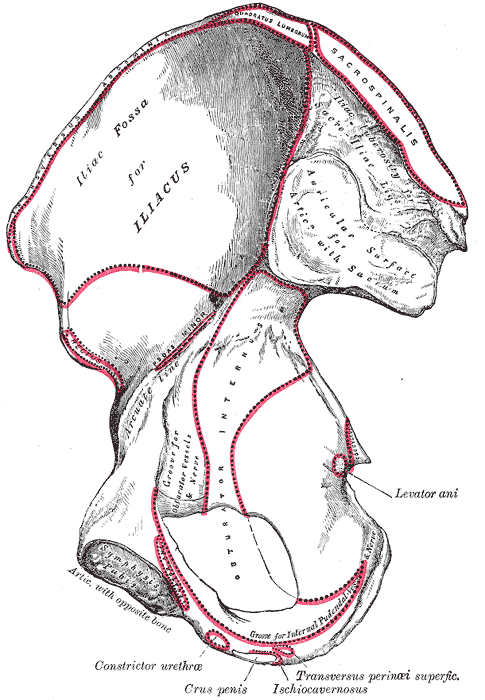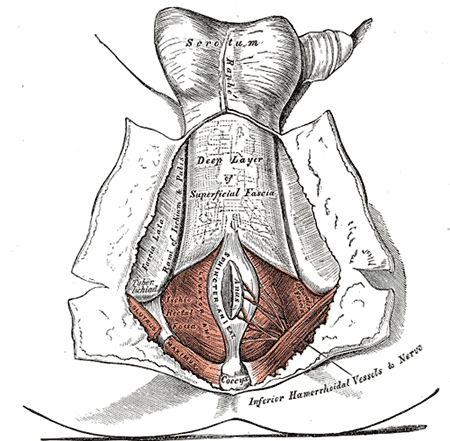[1]
MORGAN CN. The surgical anatomy of the ischiorectal space. Proceedings of the Royal Society of Medicine. 1949 Mar:42(3):189-200
[PubMed PMID: 18126986]
[2]
Loukas M, Louis RG Jr, Hallner B, Gupta AA, White D. Anatomical and surgical considerations of the sacrotuberous ligament and its relevance in pudendal nerve entrapment syndrome. Surgical and radiologic anatomy : SRA. 2006 May:28(2):163-9
[PubMed PMID: 16463079]
[3]
Montoya TI, Calver L, Carrick KS, Prats J, Corton MM. Anatomic relationships of the pudendal nerve branches. American journal of obstetrics and gynecology. 2011 Nov:205(5):504.e1-5. doi: 10.1016/j.ajog.2011.07.014. Epub 2011 Jul 20
[PubMed PMID: 21889763]
[4]
Maldonado PA, Chin K, Garcia AA, Corton MM. Anatomic variations of pudendal nerve within pelvis and pudendal canal: clinical applications. American journal of obstetrics and gynecology. 2015 Nov:213(5):727.e1-6. doi: 10.1016/j.ajog.2015.06.009. Epub 2015 Jun 10
[PubMed PMID: 26070708]
[5]
Hammer RP Jr, Shrewsbury MM. A reconsideration of the ischiorectal fossa. Diseases of the colon and rectum. 1977 Nov-Dec:20(8):681-9
[PubMed PMID: 923399]
[6]
Zhang JF, Du ML, Sui HJ, Yang Y, Zhou HY, Meng C, Qu MJ, Zhang Q, Du B, Fu YS. Investigation of the ischioanal fossa: Application to abscess spread. Clinical anatomy (New York, N.Y.). 2017 Nov:30(8):1029-1033. doi: 10.1002/ca.22901. Epub 2017 Jun 6
[PubMed PMID: 28509338]
[7]
Hogan AM, Mannion M, Ryan RS, Khan W, Waldron R, Barry K. Beware the ischiorectal abscess. International journal of surgery case reports. 2013:4(3):299-301. doi: 10.1016/j.ijscr.2012.08.005. Epub 2012 Sep 1
[PubMed PMID: 23396392]
Level 3 (low-level) evidence
[8]
Llauger J, Palmer J, Pérez C, Monill J, Ribé J, Moreno A. The normal and pathologic ischiorectal fossa at CT and MR imaging. Radiographics : a review publication of the Radiological Society of North America, Inc. 1998 Jan-Feb:18(1):61-82; quiz 146
[PubMed PMID: 9460109]
[9]
Martin R, Martin HD, Kivlan BR. NERVE ENTRAPMENT IN THE HIP REGION: CURRENT CONCEPTS REVIEW. International journal of sports physical therapy. 2017 Dec:12(7):1163-1173
[PubMed PMID: 29234567]
[10]
Zanier E, Bordoni B. A multidisciplinary approach to scars: a narrative review. Journal of multidisciplinary healthcare. 2015:8():359-63. doi: 10.2147/JMDH.S87845. Epub 2015 Aug 12
[PubMed PMID: 26316774]
Level 3 (low-level) evidence
[11]
Bordoni B, Zanier E. Skin, fascias, and scars: symptoms and systemic connections. Journal of multidisciplinary healthcare. 2013:7():11-24. doi: 10.2147/JMDH.S52870. Epub 2013 Dec 28
[PubMed PMID: 24403836]
[12]
Faubion SS, Shuster LT, Bharucha AE. Recognition and management of nonrelaxing pelvic floor dysfunction. Mayo Clinic proceedings. 2012 Feb:87(2):187-93. doi: 10.1016/j.mayocp.2011.09.004. Epub
[PubMed PMID: 22305030]
[13]
Soljanik I, Janssen U, May F, Fritsch H, Stief CG, Weissenbacher ER, Friese K, Lienemann A. Functional interactions between the fossa ischioanalis, levator ani and gluteus maximus muscles of the female pelvic floor: a prospective study in nulliparous women. Archives of gynecology and obstetrics. 2012 Oct:286(4):931-8. doi: 10.1007/s00404-012-2377-4. Epub 2012 Jun 13
[PubMed PMID: 22692630]
[14]
Bordoni B, Zanier E. Anatomic connections of the diaphragm: influence of respiration on the body system. Journal of multidisciplinary healthcare. 2013:6():281-91. doi: 10.2147/JMDH.S45443. Epub 2013 Jul 25
[PubMed PMID: 23940419]
[15]
Willard FH, Vleeming A, Schuenke MD, Danneels L, Schleip R. The thoracolumbar fascia: anatomy, function and clinical considerations. Journal of anatomy. 2012 Dec:221(6):507-36. doi: 10.1111/j.1469-7580.2012.01511.x. Epub 2012 May 27
[PubMed PMID: 22630613]


